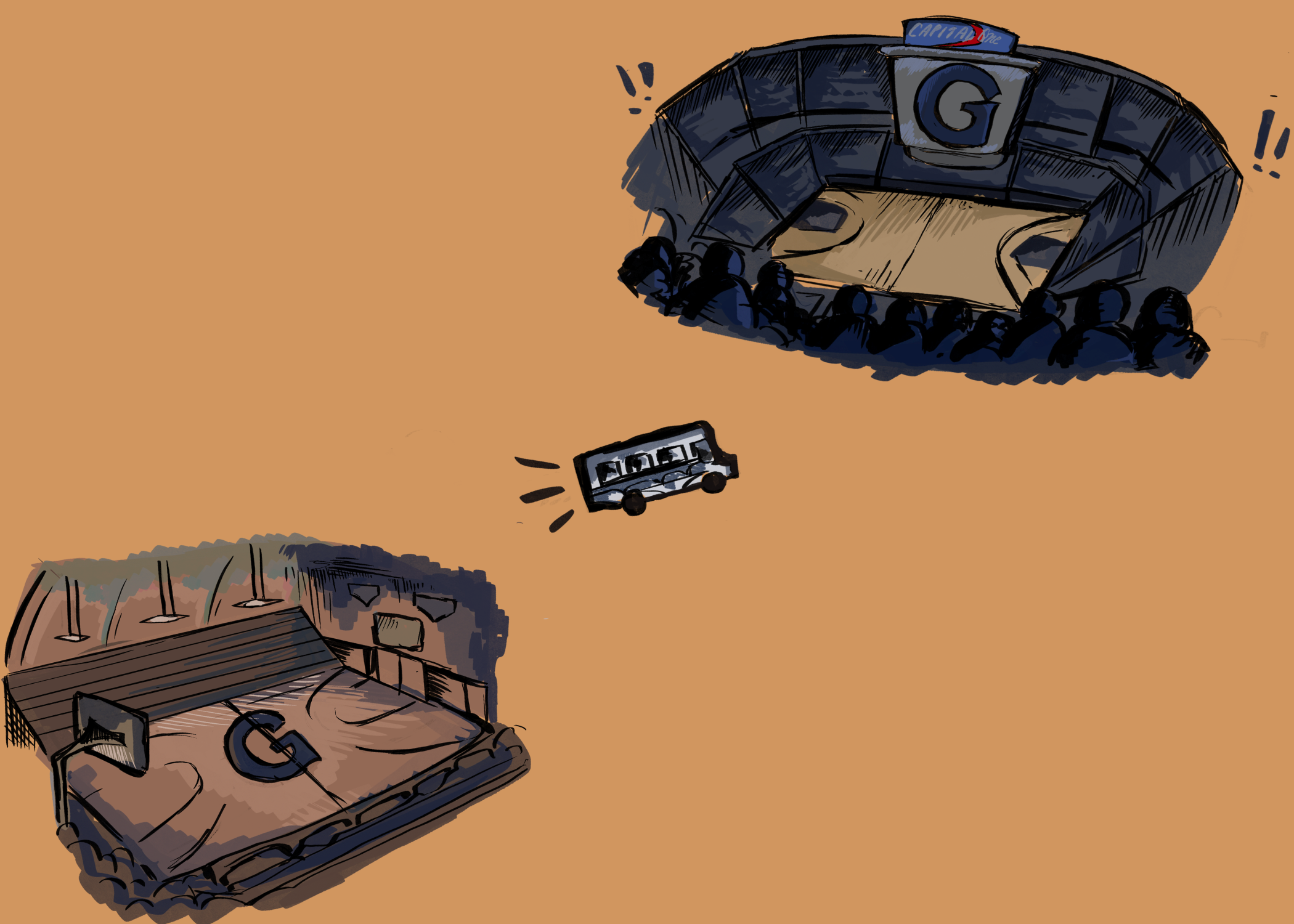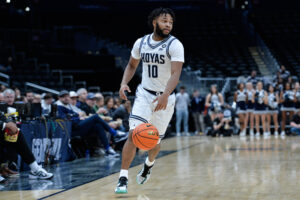It’s the end of the day. You walk to the bus outside the cafeteria. You then begin the long ride, jealous of everyone that doesn’t need to take the bus. After a pain-staking half hour in traffic listening to boys yelling in the back, you grab your backpack and get out. But you are not back in elementary school, and you did not just arrive home. You are a Hoya, at Capital One Arena, exhausted, and ready to watch a Georgetown men’s basketball game.
Every bus ride home, you’ll find yourself asking the same question: why won’t they bring back $1 beer night, and as a side note, why on Earth do we play at Capital One Arena? Or perhaps, why don’t we play on campus?
The Hoyas have played on 17 different home courts throughout their history, and only two have actually been on the Hilltop. Former homes include the George Washington, American, and Catholic University gyms, a car barn, and Odd Fellows Hall in downtown D.C.
The team played on campus in Ryan Gymnasium (now the Davis Center for Performing Arts) from 1914-1927, and in 1951, they moved to McDonough Arena (approximate capacity 4,000 at the time) when it opened its doors. This remained their home until the 1981–82 season, when the Hoyas moved to the Capital Centre in Landover, Maryland (capacity 19,035). The move aimed to accommodate the Hoyas’ growing fan base, and it did: average home game attendance shot up from 4,197 to 8,591 fans in a single season.
The Capital Centre housed the Hoyas until the 1997-98 season, when they moved to Capital One Arena (capacity 20,500). Attendance at Capital One peaked in 2007-08 with an average of 12,955 fans per game. Since, it’s been on a steady decline, with average per-game attendance not reaching 50% capacity since the 2012-13 season.
Fan attendance is a complicated problem: more fans will come to games if we win, but having fans in the stands to begin with helps teams win. Chicken or egg? There is, though, a clear explanation for Georgetown’s attendance problem beyond disappointing seasons—schlepping to Capital One is annoying.
Games at Capital One are at least a three-hour commitment: 30 minutes there, 30 minutes back, the two-ish hour game in between. If you can only make the first half because you need to study for your macro exam, the opportunity cost of the game is too high to go in the first place. Because Georgetown has no Metro station, students often rely on the university-run buses to both arrive at and leave games.
On-campus games are convenient, while also providing a much-needed dose of school spirit. Gene Smith, a former Hoya guard and member of the 1984 NCAA championship team, recalled a game in Feb. 1982 where the team played in McDonough because the Capital Centre was hosting the figure skating group Ice Capades for a 10 night engagement. The nationally-televised game against No. 4 Missouri garnered a record-breaking crowd for McDonough with over 5,000 fans. Students waited in line overnight with kegs, ready for front-row seats in the morning.
“The crowd was overflowing. We won the game and it was just an incredible experience that I don’t think any Georgetown fan that attended that game would forget,” Smith told the Voice. “The move to the Capital Centre was definitely necessary, just with the popularity of the team—McDonough couldn’t handle it. But that one game highlighted how special it was to have the students and how special it was for it to be on campus.”
There’s an obvious stumbling block to more on-campus games: there simply aren’t enough seats. Today, McDonough’s capacity has shrunk to around 2,200 seats, not enough to hold even a third of Georgetown’s undergraduate student body, and that’s not even taking into account the opponent’s fanbase.
In 2000, there was a $22 million proposal to renovate McDonough and increase capacity to around 6,500, but the plan was never realized. Today, McDonough is among the 20 oldest Division I facilities (and our women still play every game there!). While some fans have created extensive 3D models showing how to bring McDonough’s capacity to 5,600 seats, there aren’t plans for any major renovations through 2036.
However, a more realistic proposal is that Georgetown could simply play more non-conference games, which are less attended, on campus. Last year, the Hoyas took on Wagner College in McDonough because of a conflict with the Washington Wizards (read: not the Ice Capades). The stands were full, energy was up, and most importantly, we won 66-41. Smith thinks that this would strike a good balance: students could support more easily at truly “home” games, while still allowing the team to play most games in a professional arena.
Current junior guard Malik Mack agrees that it’s special to have games on campus.
“I feel like Capital One can get rowdy, but it is a big arena, it has a lot of seats you’ve got to fill in. I feel like those McDonough games are definitely a little bit more intense, you know the crowd is right there on the floor,” Mack told the Voice. “So those McDonough games are definitely a bit more fun in my eyes.”
While it seems like renovations may be out of the question in the short term, more games on campus could help cultivate the fan environment of Smith’s past and, perhaps, Mack’s future. For anyone looking to enjoy on-campus basketball, I also happen to have a readily available solution: women’s basketball, who play all of their games in McDonough! If you want to complain about trekking to Capital One, then make sure you’re also supporting our women’s teams just next door.





